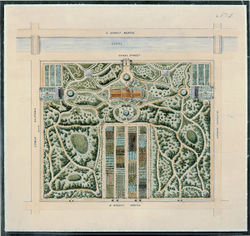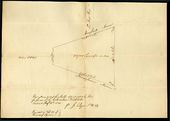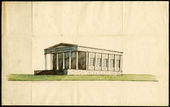Columbian Institute
[http://www.nga.gov/content/ngaweb/research/casva/research-projects.html A Project of the National Gallery of Art, Center for Advanced Study in the Visual Arts ]
Overview
Alternate Names: The Columbian Institute for the Promotion of Arts and Sciences
Site Dates: Established 1816; botanic garden in operation 1820–1837
Site Owner(s):
Associated People: Dr. Edward Cutbush (1772–1843; first president)
Location: Washington, D.C.
View on Google maps
History
x
Texts
- Anonymous, 1808, describing in the Washington Expositor the Columbian Institute, Washington, D.C. (quoted in O'Malley 1989: 102)[1]
- "Gardens and nurseries capable of receiving and propagating them, where the chemist, botanists, and agriculturalist can have free access at all seasons will it is hoped now become of peculiar interest to the patriot and legislator. . . . Within the limits of the federal seat there are large and ample reservations for public gardens and other national objects, which may advantageously be applied to the purposes of a botanical garden, a public nursery and an agricultural farm."
- Latrobe, Benjamin Henry, August 1816, "Constitution of the Columbian Institute for the Promotion of Arts and Sciences," published in The National Register (1816: 405–406)[2]
- "SECTION I.
- "Art. 1. The association shall be denominated the "Columbian Institute for the promotion of Arts and Sciences;" and shall be composed of resident and honorary members.
- "Art. 2. The objects of the Institute shall be to collect, cultivate, and distribute the various vegetable productions of this and other countries, whether medicinal, esculant, or for the promotion of arts and manufactures.
- "Art. 3. To collect and examine the various mineral productions and natural curiosities of the United States, and give publicity to every discovery which they may have been enabled to make.
- "Art. 4. To obtain information respecting the mineral waters of the United States, their locality, analysis, and utility; together with such topographical remarks as may aid valetudinarians.
- "Art. 5. To invite communications on agricultural subjects, on the management of stock, their diseases and remedies.
- "Art. 6. To form a topographical and statistical history of the different districts of the United States, noticing particularly the number and extent of streams, how far navigable; agricultural products; the imports and exports; the value of lands; the climate; the state of the thermometer and barometer; the diseases which prevail during the different seasons; the state of the arts and manufactures; and any other information which may be deemed of general utility.
- "Art. 7. To publish annually, or whenever the Institute shall have become possessed of a sufficient stock of important information, such communications as may be of public utility; and to give the earliest information, in the public papers, of all discoveries that may have been made by, or communicated to, the Institute.
- "Section II. . . .
- "Art. 3. . . .
- "No. 3.—Committee on Botany and Agriculture.
- "To this committee shall be submitted the execution of the 2d article of the 1st section of this constitution, and they shall arrange and deliver over to the Curators such specimens as will not admit of cultivation. This committee shall likewise be charged with the superintendence of the Botanical Garden, and shall report to the General Committee the progress and state of the establishment."
- Cutbush, Dr. Edward, January 11, 1817, in a lecture delivered in Congress Hall (quoted in Rathburn 1917: 13–14)[3]
- "The extensive limits of our country afford numerous opportunities for discoveries and improvements, in every branch of natural sciences. How many plants are there, natives of our soil, possessed of peculiar virtues, which would supersede the necessity of importing those that are medicinal, or necessary for the operation of the dyer! How many minerals which might serve, not only to enrich the cabinets of the curious, but minister to the wants of our growing population! What an infinite number of substances may present themselves as objects of new trade and commerce, or for the supply of the necessary materials for the various domestic arts and manufactures; and what means are so likely to bring them to our knowledge, as research and careful investigations? Therefore, considering the extent of territory embraced by the United States, whose surface and internal structure have scarcely been examined, it must be regarded as a national reproach, that we are still unacquainted with the important sources of wealth, which are yet to be opened by chemical and mineralogical enterprise. Every individual in our republic should be animated with patriotic zeal in this important undertaking. . . .
- "By establishing a botanical garden, we may not only receive instruction ourselves, but excite a spirit of enquiry in the minds of the rising generation; every parent within the District of Columbia, who is desirous of seeing his children possessed of general information, should contribute toward the establishment and support of the garden, museum, and library.
- ". . . . In short, my friends, there is scarcely an art, science, or manufacture, which may not be benefited by this association; and should we be so fortunate as to succeed in establishing a botanical garden, it may excite an emulation among the proprietors of the eminences around our city, by inducing them to cultivate and adorn those beautiful heights with gardens; no city in the United States presents a greater assemblage of sublime views; nothing is wanting but industry, public spirit, and population, to render them not only pleasing to the eye, but highly advantageous to this district."
- U.S. Congress, An Act to Incorporate the Columbian Institute, Statue I. Chapter CXXV, April 20, 1818 (Rathburn 1917: 71)[3]
- "Sec. 4. And be it further enacted, That the said corporation may procure, by purchase or otherwise, a suitable building for the sittings of the said institution, and for the preservation and safe-keeping of a library and museum; and, also, a tract or parcel of land, for a botanic garden, not exceeding five acres; Provided, That the amount of real and personal property to be held by the said corporation shall not exceed one hundred thousand dollars."
- Columbian Institute, February 3, 1821, in a draft of a memorial to Congress proposing a lottery for the Columbian Institute, Washington, D.C. (quoted in Rathburn 1917: 26)[3]
- "Under these impressions, the Institute solicit the permission to raise the necessary funds for enclosing the grounds, for the erection of their hall—their laboratory,—their hot and green houses,—their library and museum, and for the cultivation of the botanic garden, wherein they hope soon to present to the view of their fellow citizens specimens of all the plants of this middle region of our country, with others exotic and domestic; and the only plan that they can now suggest of raising the funds necessary for carrying into effect their views and endeavors to be useful will be by a lottery, which if, in some respects, liable to objection, may in some other respects be considered as a voluntary subscription for the promotion of a great national object.'"
- Columbian Institute, December 6, 1823, in a report describing the progress of the Columbian Institute, Washington, D.C. (quoted in Rathburn 1917: 43–44)[3]
- “The ground for the garden has been completely drained and partly leveled, and is in a great degree fit for cultivation. An elliptical pond had been formed 144 feet for the transverse and 100 feet for the conjugate diameter, with an island in the middle 114 feet by 85 feet. The canal that surrounds it is 15 feet wide and 2 1/2 feet deep. . . . The island wants still to be leveled for cultivation, and the upper side of the pond to be deepened to produce a level.
- "Four walks have been laid out, one on Pennsylvania Avenue, one on Maryland Avenue, one opposite the circular road around the west side of the Capitol, and one in the center of the ground leading to the pond. The three walks on the sides of the garden are 20 feet wide, with borders of 26 feet, in which to plant trees and shrubs; the center walk or road is 15 feet wide; the whole is well graveled.”
- Columbian Institute, March 6, 1826, in a memorial to Congress describing the Columbian Institute, Washington, D.C. (quoted in O’Malley 1989: 132) [1]
- "1st. The water of Tiber Creek being thus conducted into the Capitol square, will afford ample security against the progress of fire, in case of such accident taking place either in the Capitol or in any of the adjacent buildings. After leaving the Capitol, this water may be carried in pipes to the Botanic Garden, and there thrown up in a jet d'eau 30 or 40 feet high, and thence water the surrounding grounds.
- "2d. This National Botanic Garden may be used to raise all kinds of indigenous and exotic trees, shrubs, roots, grasses, &c. to be distributed to every part of the Union.
- "3d. Cool and shady walks will be formed in the neighborhood of the Capitol; the science of Botany encouraged; and a delightful scene from the Capitol created to please the eye of the stranger and citizen."
- Commissioner of Public Buildings, June 9, 1827, in a letter to the Columbian Institute, Washington, D.C. (quoted in Rathburn 1917: 45)[3]
- "The Botanic Garden belonging to your Institute is so directly in view from the Capitol, that I hope to be pardoned for a remark in relation to the improvement of it. The new section of the Washington Canal was laid out along a line drawn through the middle of the Capitol and of the Mall. The foot-way, canals & plantation in the garden do not coincide with this line, but diverge from it at an acute angle. This discrepancy is so glaring and so very offensive to the eye, that I am satisfied that every person visiting the Capitol would be grateful for its removal.
- "I would be gratified by the location of the Botanic Garden in its present site, from an expectation that it would become an ornamental appendage to the Capitol, and that under the eye of Congress they would be induced to foster it. But you are aware, Sir, that whether it shall become an ornament or deformity, depends materially upon the plan which shall be pursued in its improvement."
- Mills, Robert, February 23?, 1841, in a letter to Joel Roberts Poinsett, describing Mills's design for the National Mall (Scott, ed., 1990: n.p.)[4]
- "Agreeably to your requisition to prepare a plan of improvement to that part of the Mall lying between 7th and 12th Street West for a botanic garden...I have the honor to submit the following Report. . . .
- "The principle upon which this plan is founded is two fold, one is to provide suitable space for a Botanic garden, the other to provide locations for subjects allied to agriculture, the propagation of useful and ornamental trees native and foreign, the provision of sites for the erection of suitable buildings to accommodate the various subjects to be lectured on and taught in the Institution. . . .
- "The Botanic garden is laid out in the centre fronting and opening to the south. On each side of this the grounds are laid out in serpentine walks and in picturesque divisions forming plats for grouping the various trees to be introduced and creating shady walks for those visiting the establishments. . . .
- "The main building for the Institution is located about 300 feet south of the wall fronting the Botanic garden, from which it is separated by a circular road, in the centre of which is a fountain of water from the basin of which pipes are led underground thro' the walks of the garden, for irrigating the same at pleasure, the fountains may be supplied from the canal flowing near the north wall of inclosure." [Fig. x]
Images
Other Resources
United States Botanic Garden Official Website
Library of Congress Authority File
Notes
- ↑ 1.0 1.1 Therese O'Malley, "Art and Science in American Landscape Architecture: The National Mall, Washington, D.C. 1791–1852" (unpublished Ph.D. dissertation, University of Pennsylvania, 1989), view on Zotero.
- ↑ Benjamin Henry Latrobe, "Constitution of the Columbian Institute for the Promotion of Arts and Sciences," The National Register (Washington, D.C.) 1, no. 26 (August 24, 1816), view on Zotero.
- ↑ 3.0 3.1 3.2 3.3 3.4 Rathburn 1917, view on Zotero.
- ↑ Pamela Scott, ed., The Papers of Robert Mills (Wilmington, Del.: Scholarly Resources, 1990), view on Zotero.




